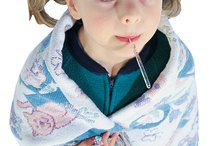Communicable diseases are caused by germs passed from one person to another. Viruses or bacteria are the most common germs causing communicable diseases.
The diseases are often transferred directly from person to person through contact with body fluids, breathing in germs released into the air or contact with the skin, especially when there are open sores. Transmission may also occur indirectly by touching a surface covered with germs.
The common cold, strep throat, gastroenteritis and herpes infections are among the most common communicable diseases.
1. Common Cold
As their name suggests, common colds are extremely common. According to the Centers for Disease Control and Prevention (CDC), adults have an average of 2 to 3 colds each year and children usually have even more 123. A runny or stuffy nose, sore throat, coughing and sneezing are typical symptoms. Tiredness, a slight fever and headaches may also occur.
Common colds are caused by viruses. Rhinoviruses are the most common cause, but more than 200 viruses can be responsible. The common cold is usually spread through water droplets containing the virus, which are made in the person’s respiratory tract and then released into the air by sneezing, coughing or simply breathing.
Another person can then catch the cold by breathing in the droplets or by touching a surface where the droplets land. There is no cure for the common cold. The infection generally worsens for a few days, then resolves on its own in 1 to 2 weeks.
- As their name suggests, common colds are extremely common.
- The common cold is usually spread through water droplets containing the virus, which are made in the person’s respiratory tract and then released into the air by sneezing, coughing or simply breathing.
2. Influenza (The Flu)
How to Diagnose Fifth Disease Vs. Hand, Foot and Mouth Disease
Learn More
The flu is similar to the common cold but is usually more severe.
**In addition to typical cold symptoms, the flu often produces muscle aches and a high fever.
** Coughing, headaches and tiredness are usually more severe than with a cold. Symptoms tend to appear suddenly with the flu and more gradually with a cold.
The flu is caused by influenza viruses, usually influenza A or influenza B.
These viruses are transferred from person to person in the same way as the common cold. People are contagious from 1 day before symptoms appear and for up to 1 week afterwards.
Three antiviral medications are available to treat influenza — oseltamivir (Tamiflu), zanamivir (Relenza) and peramavir (Rapivab). They can reduce the severity of symptoms and shorten the illness by 1 to 2 days and are most effective when started in the first 2 days of symptoms.
- The flu is similar to the common cold but is usually more severe.
- The flu is caused by influenza viruses, usually influenza A or influenza B.
- These viruses are transferred from person to person in the same way as the common cold.
3. Strep Throat
Strep throat is another disease similar to the common cold, but a sore throat is the most prominent symptom.
Strep throat usually causes a moderate to high fever. The tonsils become red and swollen and may have white spots on their surface.
A bacterium called group A Streptococcus causes strep throat_._ This bacterium is spread in a manner similar to the common cold. A rapid strep test — requiring a simple swab of the back of the throat — is used to diagnose strep throat. Antibiotics, such as penicillin, will shorten the duration of the infection. People with strep throat remain contagious until their fever is gone and they have been on antibiotics for at least 1 day.
- Strep throat is another disease similar to the common cold, but a sore throat is the most prominent symptom.
4. Fifth Disease
Rashes Following a Fever in Children
Learn More
Fifth disease is similar to the common cold — producing a runny nose, slight fever and headache — but it also causes a rash 1. The first rash is characterized by bright red cheeks, hence the name “slapped cheek” rash. This rash usually appears a few days after the cold symptoms begin. As it begins to fade, a second red rash typically appears elsewhere on the body.
In some adults, fifth disease produces only painful joints. Fifth disease is more common in children than in adults.
Also known as erythema infectiosum, fifth disease is caused by a virus called parvovirus B19 78. This virus is passed from one person to another in the same way as the common cold.
An infected person is contagious in the early stages of the illness and is usually no longer contagious by the time the first rash appears. There is no cure for fifth disease 7. It usually resolves in 5 to 10 days, although the second rash may come and go for several weeks.
- Fifth disease is similar to the common cold — producing a runny nose, slight fever and headache — but it also causes a rash 1.
- It usually resolves in 5 to 10 days, although the second rash may come and go for several weeks.
5. Gastroenteritis
Gastroenteritis — commonly called the stomach flu — is characterized by diarrhea, nausea, vomiting and abdominal pain.
A fever may be present as well. Dehydration can be a concern, especially in young children.
Norovirus is the most common cause of gastroenteritis in the United States, according to the Merck Manual 5. Rotavirus is another cause, especially in young children.
The virus is spread by the stool.
People become infected when they directly touch the stool of an infected person or when they consume food or water contaminated by virus-containing stool. There is no cure for viral gastroenteritis. It resolves on its own in 1 to 2 days or up to 10 days, depending on the virus.
- Gastroenteritis — commonly called the stomach flu — is characterized by diarrhea, nausea, vomiting and abdominal pain.
- Rotavirus is another cause, especially in young children.
6. Pink Eye
The conjunctiva becomes dark pink or red and the eye can appear slightly swollen. **A sensation of something in the eye is common.
** There is often a discharge from the eye, which can be watery or look like pus. Crusts often appear on the eyelashes and eyelids, especially in the morning.
Pink eye is usually caused by a virus or bacterium. Several viruses can produce pink eye and certain types of Staphylococcus or Streptococcus are common bacterial causes. The germ causing pink eye is often spread by direct contact with the eye discharge or when the infected person touches the eye and then another surface. There is no treatment for viral pink eye, but bacterial pink eye is treated with antibiotic eye drops.
- The conjunctiva becomes dark pink or red and the eye can appear slightly swollen.
- The germ causing pink eye is often spread by direct contact with the eye discharge or when the infected person touches the eye and then another surface.
7. Chlamydia
**Chlamydia is the most common bacterial sexually transmitted disease in the United States, according to the CDC.
** Chlamydia affects both men and women and usually produces no symptoms. When symptoms are present, discharge from the vagina or penis and burning when urinating are the most common.
Chlamydia is caused by a bacterium called Chlamydia trachomatis. This bacteria is transferred by direct contact with an infected person during sexual intercourse, including oral sex.
Ejaculation is not necessary for transmission.
The bacterium can also be transferred to a baby while being born if the mother is infected. Chlamydia is easily cured with antibiotics, such as azithromycin (Zithromax) or doxycycline (Vibramycin).
- Chlamydia is the most common bacterial sexually transmitted disease in the United States, according to the CDC.
- Chlamydia is caused by a bacterium called Chlamydia trachomatis.
- This bacteria is transferred by direct contact with an infected person during sexual intercourse, including oral sex.
8. Herpes Infections
There are 2 main types of herpes infections: genital herpes and oral herpes. Both types usually produce no symptoms. When symptoms do occur, the main symptoms are sores located in the genital area or in or around the mouth.
Oral herpes sores are commonly called cold sores or fever blisters.
The sores in both types often start as a burning sensation, then develop into a blister. The blister subsequently bursts to produce a painful open sore, which eventually crusts over.
In both types of herpes, the sores tend to intermittently reappear. A fever, generalized body achiness and tiredness may occur with the first episode but rarely with later episodes.
Herpes is caused by either herpes simplex virus type 1 or type 2 12.
Usually type 1 causes oral herpes and type 2 causes genital herpes. Oral herpes is often transferred by direct contact with the sores.
But the virus may be transmitted through contact with saliva or the area around the mouth, even when no sores are present. Genital herpes is transferred primarily by sexual contact with an infected person. Transmission does not require ejaculation and, like oral herpes, may occur even when there are no obvious sores.
No cure exists for either oral or genital herpes. But some topical antiviral medications, such as Docosanol (Abreva), can shorten the duration of cold sores.
Topical medications are not effective for genital herpes but oral antiviral medications, such as acyclovir (Zovirax), valacyclovir (Valtrex) and famciclovir (Famvir), may speed up recovery. None of these medications kill all of the virus, so future episodes are possible.
- There are 2 main types of herpes infections: genital herpes and oral herpes.
- But some topical antiviral medications, such as Docosanol (Abreva), can shorten the duration of cold sores.
9. Chickenpox
Chickenpox, or varicella, is well known for its itchy rash. The rash begins as small red blisters, which later break open and eventually crust over. A moderate fever, tiredness and poor appetite are common as well. Adults tend to have more severe symptoms than children and people who have been vaccinated against chickenpox have milder or no symptoms.
Varicella zoster virus causes chickenpox 1415. The virus is transferred by direct contact with the rash or by breathing in virus-containing water droplets released into the air from open blisters. **A person is contagious from about 1 to 2 days before the rash appears until all sores have crusted over.
There is no cure for chickenpox 1415. It resolves on its own in about 1 week. **
- Chickenpox, or varicella, is well known for its itchy rash.
- A person is contagious from about 1 to 2 days before the rash appears until all sores have crusted over.
10. Viral Hepatitis
Viral hepatitis occurs when a virus infects the liver, producing inflammation and destroying liver cells. There are 3 main types, depending on the virus: hepatitis A, hepatitis B and hepatitis C.
Hepatitis A is transmitted from person to person in the same manner as viral gastroenteritis.
There is no cure for this type of viral hepatitis. It typically resolves within 2 months.
Hepatitis B is transferred by contact with body fluids, including blood, semen and saliva. However, sharing eating utensils, sneezing, coughing and hugging will not transmit hepatitis B, according to the CDC.
Sometimes hepatitis B causes no symptoms at the time of the initial infection, but the virus can remain in the body and cause chronic hepatitis, which may eventually lead to liver failure or cancer. There is no cure for hepatitis B 17.
Hepatitis C is primarily transferred by direct contact with the blood of an infected person. A lack of initial symptoms and the development of chronic hepatitis are even more common than with hepatitis B.
Highly effective medications called direct-acting antiviral agents are now available. They can cure over 90 percent of people with chronic hepatitis C, according to the CDC.
- Viral hepatitis occurs when a virus infects the liver, producing inflammation and destroying liver cells.
- A lack of initial symptoms and the development of chronic hepatitis are even more common than with hepatitis B.
- Highly effective medications called direct-acting antiviral agents are now available.
Prevention
Vaccines are available for the flu, rotavirus gastroenteritis, chickenpox, hepatitis A and hepatitis B.
They reduce the chances of developing the disease or at least decrease its severity. Talk to your doctor about which vaccines are appropriate for you.
**If you have a communicable disease, ask your doctor how to avoid giving it to someone else.
** For many diseases, this will involve staying home while you're in the contagious period.
Limiting the spread of communicable diseases depends on the method of transmission. These are some common preventive measures:
Reviewed and revised by Mary D. Daley, M.D.
- Vaccines are available for the flu, rotavirus gastroenteritis, chickenpox, hepatitis A and hepatitis B.
- They reduce the chances of developing the disease or at least decrease its severity.
- For many diseases, this will involve staying home while you're in the contagious period.
Related Articles
References
- Centers for Disease Control and Prevention: Common Cold and Runny Nose
- Centers for Disease Control and Prevention: Common Colds -- Protect Yourself and Others
- Centers for Disease Control and Prevention: Strep Throat
- Merck Manual Professional Version: Overview of Gastroenteritis
- Centers for Disease Control and Prevention: Conjunctivitis (Pink Eye) -- For Clinicians
- Centers for Disease Control and Prevention: Parvovirus B19 and Fifth Disease
- Merck Manual Professional Version: Erythema Infectiosum (Fifth Disease; Parvovirus B19 Infection)
- Lippincott’s Guide to Infectious Disease; Dorothy Borton, et al.
- Centers for Disease Control and Prevention: Chlamydia -- CDC Fact Sheet (Detailed)
- World Health Organization: Herpes Simplex Virus
- Centers for Disease Control and Prevention: Genital Herpes -- CDC Fact Sheet (Detailed)
- Centers for Disease Control and Prevention: Chickenpox (Varicella) -- Signs and Symptoms
- Centers for Disease Control and Prevention: Hepatitis A Questions and Answers for Health Professionals
- Centers for Disease Control and Prevention: Hepatitis B Questions and Answers for Health Professionals
- Centers for Disease Control and Prevention: Hepatitis C Questions and Answers for Health Professionals
- Vere Hodge RA, Field HJ. Antiviral agents for herpes simplex virus. Adv Pharmacol. 2013;67:1-38. doi:10.1016/B978-0-12-405880-4.00001-9
- National Institute of Health. Herpes Can Happen to Anyone. NIH News in Health. 2018.
- Glinšek Biškup U, Uršič T, Petrovec M. Laboratory diagnosis and epidemiology of herpes simplex 1 and 2 genital infections. Acta Dermatovenerol Alp Pannonica Adriat. 2015;24(2):31-5.
- InformedHealth.org. Cold sores: Overview. Cologne, Germany: Institute for Quality and Efficiency in Health Care (IQWiG); 2018.
- Sauerbrei A. Herpes Genitalis: Diagnosis, Treatment and Prevention. Geburtshilfe Frauenheilkd. 2016;76(12):1310-1317. doi:10.1055/s-0042-116494
- Bradley H, Markowitz L, Gibson T, et al. Seroprevalence of herpes simplex virus types 1 and 2—United States, 1999–2010. J Infect Dis. 2014;209(3):325-33. doi:10.1093/infdis/jit458
- Centers for Disease Control and Prevention. Genital Herpes - CDC Fact Sheet. Updated August 28, 2017.
- Centers for Disease Control and Prevention. Genital Herpes - CDC Fact Sheet (Detailed). Updated January 31, 2017.
- Mccarthy JP, Browning WD, Teerlink C, Veit G. Treatment of herpes labialis: comparison of two OTC drugs and untreated controls. J Esthet Restor Dent. 2012;24(2):103-9. doi:10.1111/j.1708-8240.2011.00417.x
Writer Bio
Norene Anderson has been a writer since 2003. She is also a registered nurse with expertise in a wide range of medical conditions and treatments. Anderson received her associate degree in nursing from Lincoln University in Jefferson City, Mo.









